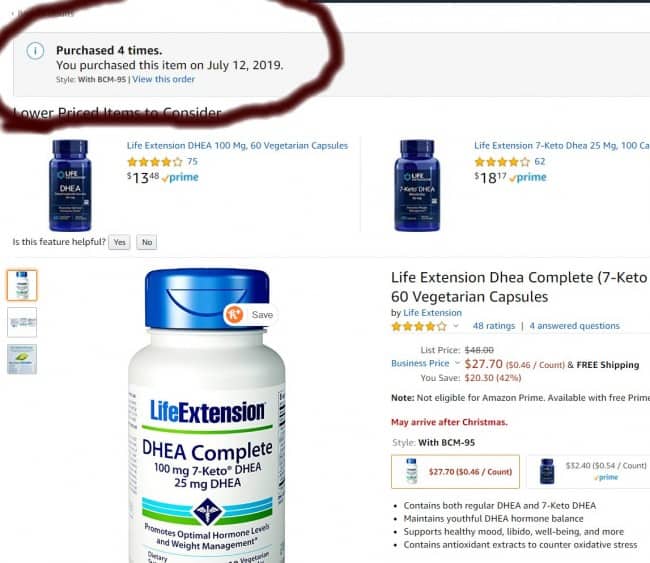DHEA
So there are hormone systems in the body which involve testosterone in males and estrogen in females. Those hormones are vital in the performance of the young male or young female dog or cat, reproductively, as well as for strength, endurance, overall health, muscle mass bone density fitness. Very solid studies have demonstrated that sex-hormones a protective for many cancers, decreasing the odds of cancer in people and animals (when present) by 8-10%.
In people these crucial hormones are produced in the “gonads” which are the testicles or the ovaries.
People and animals also synthesize DHEA in their gonads. Humans (not animals) can also produce DHEA in their adrenal gland and that matters as you will soon see.
But let’s stick a pin in that.
Science has discovered another hormone called “DHEA” which functions at the cellular level very much the way our sex hormones affect us. High levels of DHEA in male tissue can elicit some of the same changes as testosterone. In females high levels of DHEA may function beneficially as estrogen. In humans, DHEA is produced in the adrenal glands at a certain basic level.
In the dog however, DHEA is produced ONLY in the gonad.
So here’s the thing, in a dog or cat when you spayed or neutered them, you are removing their sex hormones as well as their DHEA because they do not produce DHEA in their adrenal gland. The “adrenal” is the gland we leave behind when we performed ‘gonadectomy’ for a pet.
So your animal has no hormonal support of any kind, for its lifetime, not even DHEA. And there is a price to be paid (long-term) for that.
So a recent “fad – bandwagon” in television / Youtube Vet practice is administering DHEA to animals hoping to appreciate some of the benefits of hormones support on those animals. And in fact the results are initially encouraging.

However, when you put DHEA into an animal system, you are giving a signal for tissue building, and the activation of a lot of activity, metabolically. In other words the body suddenly needs the building blocks for the processes that the DHEA is calling up. Sadly there is not a limitless supply of these building blocks and so certain enzyme systems such as nADP and nADPH are exhausted with time, as
DHEA is given. Does it matter in a year? Probably not.
But for long-term use of DHEA, or high dose DHEA, research has been done to determine what enzymes and compounds become deficient metabolically in animals given DHEA; and research is forging ahead to try to bring a product (of a safer nature) to market in 2019. In the meantime supplement of high-dose DHEA to dogs should be endeavored only when the benefits outweigh the negative side effect of metabolite exhaustion.
In my opinion any dogs that is ill, very old, suffering a deteriorating quality-of-life, have little to lose in the effort to gather the benefits of DHEA therapy versus the eventual exhaustion of certain metabolic
processes. Anti-cancer benefit have been noted with DHEA supplementation, research on that is continuing.
Weight Dose Times Per Day
< 10 lb give 5 to 10 mg – 1-2x daily
10-20 lb give 25mg – 1x daily
20-30 lb give 25mg – 2x daily
30-50 lb give 50mg – 2x daily
50-80+ lb give 100mg 2x daily
Some dogs experience agitation. (That’s been 2-3 cases in as many years. Which is why MORNING dosing is good.
Some dogs can have a very untoward reaction to DHEA. That is uncommon, but it looks like this: Fever, joint pain, skin rash and even sores around the mouth and eyes. That’s CRAZY rare and may not even happen in dogs. It happens in people sometimes, and they don’t know why. (Stevens-Johnson Syndrome)
Obtaining DHEA can be simple, but there are caveats. For this to be even worth it, you might want to get a pharmaceutical grade DHEA which are available on Amazon.com and here are the names of two
laboratories that will produce and sell pharmaceutical grade: “Douglas Labs” and “Pure Encapsulations”. Both are commonly relied upon by medical professionals in the human field.
As with any promising nutritional supplement, the FDA has not had time to evaluate the many assertions made about DHEA, and we know there are some risks in terms of a reaction among certain dogs as well as eventual deleterious effects latently and possibly sub clinically. In the meantime the benefits probably outweigh those risks. If your pet is weak, very old, sick, or experiencing a deterioration in quality-of-life, which is the reason this information is being provided for you and this recommendation is being made.
What follows is my 2019 Review of DHEA and canines, felines. It’s based on case experience and has some revised dosing and precautions.

© 2018 Dr Erik Johnson – johnsonvet.com/DHEA






